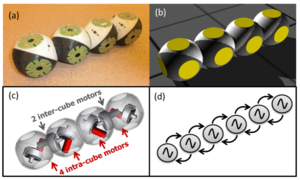Gait Optimization for Roombots Modular Robots - Matching Simulation and Reality
2013
Conference Paper
dlg
The design of efficient locomotion gaits for robots with many degrees of freedom is challenging and time consuming even if optimization techniques are applied. Control parameters can be found through optimization in two ways: (i) through online optimization where the performance of a robot is measured while trying different control parameters on the actual hardware and (ii) through offline optimization by simulating the robot’s behavior with the help of models of the robot and its environment. In this paper, we present a hybrid optimization method that combines the best properties of online and offline optimization to efficiently find locomotion gaits for arbitrary structures. In comparison to pure online optimization, both the number of experiments using robotic hardware as well as the total time required for finding efficient locomotion gaits get highly reduced by running the major part of the optimization process in simulation using a cluster of processors. The presented example shows that even for robots with a low number of degrees of freedom the time required for optimization can be reduced by a factor of 2.5 to 30, at least, depending on how extensive the search for optimized control parameters should be. Time for hardware experiments becomes minimal. More importantly, gaits that can possibly damage the robotic hardware can be filtered before being tried in hardware. Yet in contrast to pure offline optimization, we reach well matched behavior that allows a direct transfer of locomotion gaits from simulation to hardware. This is because through a meta-optimization we adapt not only the locomotion parameters but also the parameters for simulation models of the robot and environment allowing for a good matching of the robot behavior in simulation and hardware. We validate the proposed hybrid optimization method on a structure composed of two Roombots modules with a total number of six degrees of freedom. Roombots are self-reconfigurable modular robots that can form arbitrary structures with many degrees of freedom through an integrated active connection mechanism.
| Author(s): | Möckel, Rico and Yura, N. Perov and The Nguyen, Anh and Vespignani, Massimo and Bonardi, Stephane and Pouya, Soha and Spröwitz, Alexander and van den Kieboom, Jesse and Wilhelm, Frederic and Ijspeert, Auke Jan |
| Book Title: | Proceedings of the 2013 IEEE/RSJ International Conference on Intelligent Robots and Systems |
| Pages: | 3265--3272 |
| Year: | 2013 |
| Publisher: | IEEE |
| Department(s): | Dynamic Locomotion |
| Bibtex Type: | Conference Paper (inproceedings) |
| DOI: | 10.1109/IROS.2013.6696820 |
| Address: | Tokyo |
|
BibTex @inproceedings{escidoc:2316379,
title = {Gait Optimization for Roombots Modular Robots - Matching Simulation and Reality},
author = {M{\"o}ckel, Rico and Yura, N. Perov and The Nguyen, Anh and Vespignani, Massimo and Bonardi, Stephane and Pouya, Soha and Spr{\"o}witz, Alexander and van den Kieboom, Jesse and Wilhelm, Frederic and Ijspeert, Auke Jan},
booktitle = {Proceedings of the 2013 IEEE/RSJ International Conference on Intelligent Robots and Systems},
pages = {3265--3272},
publisher = {IEEE},
address = {Tokyo},
year = {2013},
doi = {10.1109/IROS.2013.6696820}
}
|
|



